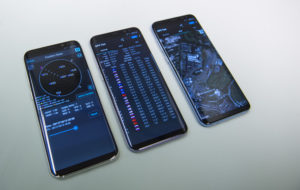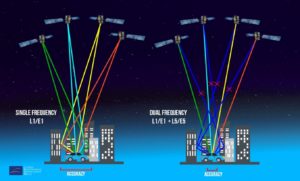Students and research trainees across Europe are invited to take part in ESA’s new Galileo smartphone app competition – to develop an app capable of performing fixes using raw Galileo satnav measurements.
Run by ESA in collaboration with the European Global Navigation Satellite Systems Agency – GSA – plus the European Commission with the support of Google, this Galileo app competition is open to all students from European universities and trainees in posts at European research and development organisations.
Following on from last year’s inaugural competition – which has already resulted in the winning app becoming publicly available – this year’s event challenges teams to make use of the dual frequency capability of the latest Android 8.0 smartphones, to compute dual frequency positioning solutions from raw satnav signals to compare them with their single frequency equivalents.
“The inaugural Galileo smartphone app competition was open solely to ESA graduate trainees, but the response was so great that this time we have opened up to students and young researchers across Europe, forming teams of three to five people,” explains ESA Galileo Services Engineering Manager Rafael Lucas Rodriguez.
The set objective is to reach sub-metre accuracy worldwide in unobscured sky conditions. The app should allow the user to select Galileo-only positioning, GPS-only positioning and the combination of both on a simultaneous basis, with the potential to include other satnav constellations in turn.
The receiver chipsets inside smartphones routinely make use of Galileo in combination with several other satnav constellations – the US GPS, Russian Glonass and Chinese BeiDou. These chipsets function in ‘black box’ style, making the resulting positioning fixes accessible to users, but without giving any option to the user to select which constellation to employ – or information on Galileo’s particular contribution to the phone’s overall positioning performance.
However, in newer Android smartphones it has become possible to access the raw signal measurements used to compute position, opening the door to the development of applications where the user can indeed select which constellations to employ.
The very latest models also allow the use of dual satnav frequencies, giving a major boost to positioning precision. The higher chip rate of the additional frequency allows the chipset to compensate for signal propagation errors from the signals’ journey through the ionosphere – the electrically active outer layer of atmosphere – and reduces false ‘multipath’ detections caused by signals reflecting off buildings.
“As a first step, teams submit a proposal of not longer than 20 pages, summarising the application to be developed,” explains ESA navigation engineer Nityaporn Sirikan. “These proposals will be evaluated by a jury composed of representatives of ESA, GSA, the EC and Google, with the top five proposals selected to develop their app further, receiving on loan a state-of-the-art dual frequency satnav smartphone and receiving general guidance and technical support.”
The competition launches on 24 September 2018, and teams are invited to submit their proposals to Galileo.Services@esa.int by 12 November, to be informed of the jury’s response to their proposal by 26 November. The competition final is scheduled for 18 April next year at ESA’s ESTEC technical centre in Noordwijk, the Netherlands.
The first and second prize-winning teams will win attendance to the ESA & EC International Summer School on Global Navigation Satellite Systems in Portugal. Additional prizes will be available to the most innovative app and the winner of a public online vote, to be undertaken during the final.
Want to know more? Register for our competition information day at ESTEC on 16 October via Galileo.Services@esa.int. Read the full terms and conditions here.


